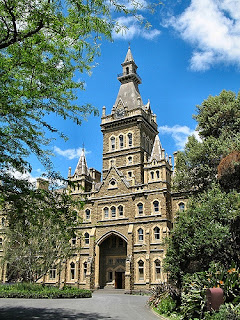University of Melbourne, located in Melbourne, Victoria (Australia), is the second oldest university in Australia, and the oldest in Victoria. Its main campus is located in Parkville, just north of downtown Melbourne.
University of Melbourne holding the top ranking universities in Australia and the world rankings. In the field of social sciences, cultural sciences and biomedicine, the university has a high prestige.
The University has nearly 40,000 students, and supported by nearly 6,000 staff. On 15 November 2005, the Vice-Chancellor Glyn Davis announced a program called Growing Esteem changes. Within this program, University of Melbourne will try to consolidate the three main activities: Research, Learning, and the transfer of knowledge-to become one of the best institutions in the world. Scholarship in the university structure will then be converted into the Melbourne Model, which is a combination of several practices of American and European universities. According to its proponents, this is in accordance with the Bologna Agreement that will ensure the scholarship program will have international relevance.
History
 |
| TheUniversity of Melbourne |
Cussonia Court, home of the School of Classics and Philosophy.
Melbourne University was founded by Hugh Childers Auditor-General and Minister of Finance in his first Budget Speech, on 4 November 1852, which set aside a sum of £ 10,000 for the establishment of a university. University was established by the Constitution of the Company on January 22, 1853, with the power to confer degrees in arts, medicine, law, and music. The act provided for an annual donation of £ 9,000, while a special grant of £ 20,000 made to the building that year. The foundation stone was laid on July 3, 1854, and on the same day the foundation stone for the State Library Classes start in 1855 with three professors and sixteen students; of the student body, only four graduated. The original buildings were officially opened by the Lieutenant Governor of the Colony of Victoria, Sir Charles Hotham, on October 3, 1855. The first Chancellor, Redmond Barry (later Sir Redmond), served until his death in 1880.
In the early days of the university, a master-plan architecture is developed, establishing the intended prevailing building style as gothic revival. Influential architects including Melbourne's own initial Joseph Reed, who is responsible for the design of many of the early campus buildings. Although the master-plan is followed until the 1930s, the 1950s saw the modernist style was established as a "house style" new, so the mix of university buildings seen today.
The inauguration of the university was made possible by the wealth generated from gold rush Victoria. The institute is designed to be "the influence of civilization" on a fast turnaround time and commercial growth (Selleck, 2003). This set of secular and excluded from the offer degrees in divinity - the churches can be established only in perimeter college north. The local population largely rejected supposed elitism of the professor, teaching benefit from the 'useful' subjects like law, more than those they deemed 'useless' in the context of the city, like a classic. Residents of this city won this debate, and the law was introduced in 1857, and medicine and engineering in the 1860s.
Recognition of women in 1881 was more a victory for Victoria over the board's decision is more conservative (Selleck 2003, pp. 164-165). Subsequent years saw tensions over the direction the university is emerging and, in 1902, was effectively bankrupt following the discovery of ₤ 24 000 fraudulent abuse of trust by the university's treasurer, Frederick Dickson, during the period 1886 to 1901 (when the annual grant is £ 15,000). Dickson was jailed for seven years.
This resulted in a royal commission recommended a new funding structure, and the expansion of the discipline to agriculture and education.
At the time of World War I, the government again pressing concern. Council, which consists of business people more than professors, obtained real power at the expense of the senate in 1923. Students can choose two members of the board. In this period, students tend to come from wealthy backgrounds, with little opportunity scholarships for gifted students. The first vice-chancellor to be paid the salary was Raymond Priestley (1936) followed by John Medley in 1939.
After World War II, demand for Commonwealth-funded student places grew in Australia and the university met the demand, a much larger and more inclusive.
University's 150th anniversary was celebrated in 2003.
library
Melbourne University Library is one of the busiest libraries in Australia, with three million visitors a loan of 42 million transactions each year. General collection consists of more than 3.5 million items including books, DVDs, slide photographs, music scores, periodicals, as well as rare maps, prints and other published materials. The library also holds over 32,000 e-books, hundreds of databases and 63,000 general and specialist journals in digital form.
The library includes:
Architecture Library
Baillieu Library (arts and humanities)
Brownless Biomedical Library
chemical Libraries
geology Library
Eastern Resource Centre (ERC)
Giblin Economics and Commerce Library
Land and Food Resources (LFR) (Burnley, Creswick, Dookie)
law library
Lenton Parr Music, Visual and Performing Arts Library (formerly Library VCA)
Louise Hanson-Dyer Music Library
mathematical Library
Physics Research Libraries
Veterinary Science Library
Library personnel also provide advice to staff and students on issues such as copyright, information management, knowledge management, information architecture and business process design.
Permalink : University of Melbourne,The Second Oldest University in Australia
Sharing Caring :

0 comments:
Post a Comment